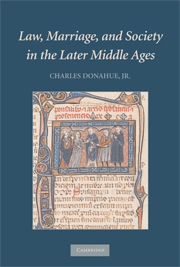Book contents
- Frontmatter
- Contents
- List of Tables
- List of Appendices
- Preface
- Acknowledgments
- Notes About This Book
- Introduction
- 1 The Background Rules and Institutions
- 2 Lying Witnesses and Social Reality: Four English Marriage Cases in the High Middle Ages
- 3 Statistics: The Court of York, 1300–1500
- 4 Story-Patterns in the Court of York in the Fourteenth Century
- 5 Story-Patterns in the Court of York in the Fifteenth Century
- 6 Ely
- 7 Paris
- 8 Cambrai and Brussels: The Courts and the Numbers
- 9 Cambrai and Brussels: The Content of the Sentences
- 10 Divorce a mensa et thoro and salvo iure thori (Separation)
- 11 Social Practice, Formal Rule, and the Medieval Canon Law of Incest
- 12 Broader Comparisons
- Epilogue and Conclusion
- Bibliography and Abbreviations
- Subject Index
- Texts and Commentary
- Table of Cases
- Table of Authorities
- Index of Persons and Places
4 - Story-Patterns in the Court of York in the Fourteenth Century
Published online by Cambridge University Press: 14 July 2009
- Frontmatter
- Contents
- List of Tables
- List of Appendices
- Preface
- Acknowledgments
- Notes About This Book
- Introduction
- 1 The Background Rules and Institutions
- 2 Lying Witnesses and Social Reality: Four English Marriage Cases in the High Middle Ages
- 3 Statistics: The Court of York, 1300–1500
- 4 Story-Patterns in the Court of York in the Fourteenth Century
- 5 Story-Patterns in the Court of York in the Fifteenth Century
- 6 Ely
- 7 Paris
- 8 Cambrai and Brussels: The Courts and the Numbers
- 9 Cambrai and Brussels: The Content of the Sentences
- 10 Divorce a mensa et thoro and salvo iure thori (Separation)
- 11 Social Practice, Formal Rule, and the Medieval Canon Law of Incest
- 12 Broader Comparisons
- Epilogue and Conclusion
- Bibliography and Abbreviations
- Subject Index
- Texts and Commentary
- Table of Cases
- Table of Authorities
- Index of Persons and Places
Summary
At the end of Chapter 3, we suggested, tentatively, that the York court in the later fourteenth century played a role that allowed it to redress, at least to some extent, the imbalance in power between women and men that prevailed in the period. Assuming that this is correct, two questions immediately come to mind: First, if the court's role had this effect in the cases that were litigated, did it have any effect on people who did not litigate? Obviously our records do not give us any direct evidence to answer this question, and the picture that we get from other types of records, both of medieval marriage and of gender relations, is very different from what we see in the court records. Nonetheless, perhaps with more courage than wisdom, we will eventually suggest that what this court and others like it were doing did have an effect beyond the effect on the parties to the cases, albeit over a very long term and with considerable crosscurrents that make it seem at times as if the effect were not there at all.
Second, once again assuming that the York court was having this effect, was the court aware of it? Certainly no one connected with the court would have put it in these terms, but then no one in the fourteenth-century court of York was familiar with the terms of historical sociology.
- Type
- Chapter
- Information
- Law, Marriage, and Society in the Later Middle AgesArguments about Marriage in Five Courts, pp. 90 - 151Publisher: Cambridge University PressPrint publication year: 2008



